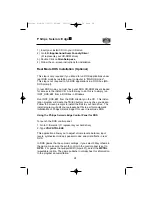
Philips Seismic Edge
38
4.
MIDI Tab
NOTE!: When your card is initially installed the SXG Softsynth
is selected as your MIDI engine. The SXG IS NOT CON-
TROLLED ON THIS TAB BUT IN A SEPARATE CONTROL PANEL.
See details below.
Your Seismic Edge
sound card includes two distinct wavetable
music synthesis engines. The Yamaha SXG is an extremely high
quality, high polyphony (512 simultaneous voices) MIDI synthesis
engine with both GM and XG compatibility. Select the SXG for the
richest music experience. The Seismic Edge WaveTable Synth is a
pure hardware synthesis engine designed for use with games or
other applications where low CPU consumption is critical. Select the
Seismic Edge WaveTable Synth only for games that utilize MIDI for
music. Note that most current PC games do not use MIDI music so
typically the SXG Softsynth can be left selected even when playing
games. These games use digital sound recordings exclusively and
are not effected by MIDI output selection.
When your card is initially installed the SXG Softsynth is selected as
your MIDI engine. To view or change your selection:
1.
Select "Start" then "Settings" on the Windows
Taskbar.
2.
Double click on the Multimedia properties icon.
3.
Select the MIDI tab.
4.
"Single instrument" will be selected
5.
Look at the box under "Single instrument" to determine what
MIDI output (engine) is currently selected.
6.
To change to a different MIDI output select it then select
"Apply" or "OK". You can select either "Yamaha SXG Driver"
(typical), "Seismic Edge WaveTable Synth" (games with
MIDI) or Seismic Edge External (if you have an external
synthesizer connected to the Game/MIDI port of the card).
To adjust the SXG Softsynth:
1.
The SXG is not affected by the controls under the MIDI tab of
the Seismic Edge control panel.
Philips 4-ch-091100-11-40.qxd 2000/9/11 AM 11:39 Page 38






























